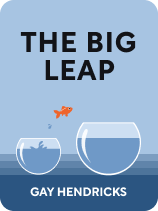

This article is an excerpt from the Shortform book guide to "The Big Leap" by Gay Hendricks. Shortform has the world's best summaries and analyses of books you should be reading.
Like this article? Sign up for a free trial here .
What are the four levels of success? What’s the highest level of success you can achieve in life?
According to Gay Hendricks, there are four distinct levels of success people occupy. These levels can be described as 1) stagnancy, 2) adequacy, 3) high achievement, and 4) state of fulfillment. As we accomplish more in life, we move through subsequently higher levels.
Keep reading to learn about the four levels of success and their key characteristics, according to Hendricks.
#1: Stagnancy
In this level of life, Hendricks explains, you accomplish little to nothing because you waste time and energy on doing things you’re not good at, rather than on things you excel at. You’re continually frustrated and spinning your wheels, because you aren’t homing in on your skills and talents, and you stubbornly refuse to admit that there are just some things you aren’t cut out for. For example, you may be stuck in a dead-end job you hate, or unable to hold down jobs, and you feel like a failure. In fact, the problem may be that you’re just not pursuing what you’re good at. You might be achieving much more in a different career path that’s more aligned with your natural abilities.
| Discover Your “Sparketype” If you find yourself at the level of stagnancy, you may need to do some work around discovering what your unique skills and talents are, so you can apply that knowledge to your career path. To help people do this, best-selling author Jonathan Fields has developed The Sparketype Assessment. Through a series of questions about your personal likes, dislikes, interests, ideals, and values, this assessment reveals the “driving force” behind what makes you you, and what gives you a sense of purpose in life—this is your “Sparketype.” Once you’ve identified your Sparketype, you can use that to identify why you may currently be stagnating and how you might better incorporate your passions into your career path. |
#2: Adequacy
At this level, you appear to be doing fine; you’ve achieved some level of success and are making progress. You may be on par with your peers, but not really excelling beyond them. For example, if your friends and family think you’re “doing well” but you still feel like you’re falling short of your potential, or you find you’ve hit a wall in terms of advancement, you may be stuck at the level of adequacy. To go beyond adequacy, Hendricks advises that you may just need to re-focus and re-prioritize, thinking a bit outside the box to imagine how you could aim a little higher.
| Set Extreme Goals In The 10X Rule, Grant Cardone warns against settling for average or mediocre goals for success. One problem with doing this is that often those goals are set by others, rather than by yourself. They tend to be goals that adhere to the societal norm, so by definition they never take you beyond that, and they’re also not strongly motivating since they’re not uniquely your goals. Cardone claims that by setting simply adequate, you set yourself up for achieving less than that if and when you experience any setbacks. So, he says to achieve great success, you must aim much higher than you otherwise would have. Set your goals 10 times higher, and work 10 times harder to achieve them. |
#3: High Achievement
At this level, you’ve reached a degree of accomplishment that others admire. You’re good at what you do, and you’re solidly “successful” according to society’s standards. You can get very comfortable in this zone, because on the surface you may look and feel like you’ve reached your highest potential. But Hendricks warns us that there are two potential problems when you reach this level of achievement:
1. You still have a nagging sense that something is missing in your life. Deep down something tells you there must be more, but you can’t put your finger on what it is. This is your inner calling to true fulfillment beckoning you.
2. This is also where you’re in danger of encountering the Upper Limit Problem, which acts as a barrier to reaching that state of fulfillment. These two forces—your call to fulfillment and your upper limit—work against each other at this level. When you feel the satisfaction of this much accomplishment, you’re likely to begin to engage in self-sabotage, to ensure you don’t go beyond that. This is due to deep-seated feelings of unworthiness or other limiting beliefs we’ll discuss in the next section.
(Shortform note: In The Happiness Trap, Russ Harris explains that humans aren’t hard-wired for happiness, and the pursuit of that often has the opposite result. We’re driven to accumulate as a survival instinct, but in the modern world, this relentless drive to acquire more material wealth keeps us in a vicious cycle because we never know when enough is enough. This is similar to how Hendricks describes the High Achievement level of success, and why such people may still feel like something is missing.)
#4: State of Fulfillment
According to Hendricks, this is the level we’re all meant to reach in life—it’s your true life purpose. When you transcend the limitations of your upper limit, you reach your highest potential, and there’s no boundary on the amount of love, wealth, and joy you can experience. In this state, you’re not just achieving, but thriving. Hendricks describes this as breaking out of all the “boxes” of the previous levels and living a life of limitless expansion.

———End of Preview———
Like what you just read? Read the rest of the world's best book summary and analysis of Gay Hendricks's "The Big Leap" at Shortform .
Here's what you'll find in our full The Big Leap summary :
- How to overcome the psychological barriers to success and fulfillment
- Why most people have a self-imposed limit to happiness
- How to identify your own false beliefs and stop self-sabotaging






